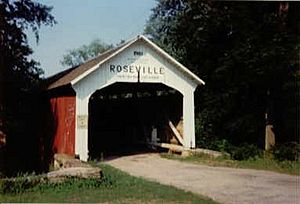Roseville-Coxville Covered Bridge facts for kids
Quick facts for kids Roseville Covered Bridge |
|
|---|---|

Roseville Covered Bridge
|
|
| Coordinates | 39°39′8.03″N 87°17′37.8″W / 39.6522306°N 87.293833°W |
| Carries | C.R. 325W |
| Crosses | Big Raccoon Creek |
| Locale | Roseville, Indiana, Parke, Indiana, United States |
| Official name | Roseville Covered Bridge |
| Other name(s) | Coxville Covered Bridge |
| Named for | Roseville, Indiana |
| Maintained by | Parke County |
| NBI Number | 6100042 |
| Characteristics | |
| Design | National Register of Historic Places |
| Total length | 281 ft (86 m) |
| Width | 16 ft (4.9 m) |
| Height | 12.66 ft (3.86 m) |
| History | |
| Constructed by | J. J. Daniels |
| Rebuilt | 1977 |
| MPS | Parke County Covered Bridges TR |
| NRHP reference No. | 78000409 |
| Added to NRHP | Dec 22, 1978 |
| Lua error in Module:Location_map at line 420: attempt to index field 'wikibase' (a nil value). | |
The Roseville Covered Bridge, also known as the Coxville Covered Bridge, is a cool old bridge located southeast of Mecca, Indiana. It's a special type of bridge called a Burr Arch covered bridge. This means it has a unique design with strong wooden arches inside.
The bridge was built in 1910 by a famous builder named Joseph J. Daniels. This wasn't the first bridge at this spot; it's actually the third one! The Roseville Covered Bridge was added to the National Register of Historic Places in 1978. This means it's recognized as an important historical site.
Contents
Building the Roseville Covered Bridge
This section tells the story of how the Roseville Covered Bridge came to be. It covers why a new bridge was needed and who helped build it.
Why a New Bridge Was Needed
In 1910, the old Roseville Covered Bridge, which was built in 1865, was destroyed. The local government, called the Parke County Commissioners, had to decide what to do. They first thought about building a modern concrete bridge.
However, building a concrete bridge turned out to be too expensive. So, they decided to build another covered bridge instead. This was a good choice! Another bridge downstream, the Armiesburg Covered Bridge, was replaced with concrete in 1917. But that concrete bridge fell apart just 13 years later in 1930. The Roseville Covered Bridge, made of wood, is still standing strong today!
Who Built the Bridge?
A man named Jefferson P. Van Fossen won the job to build the new bridge. He and his brother, J. L. Van Fossen, worked a lot with the county's road department. They helped build at least four covered bridges and their foundations in Parke County. Jefferson P. Van Fossen also built the Jessup Covered Bridge in the same year, 1910.
Some people who were there during the construction said that the foreman (the person in charge on site) was J. J. Daniels. He would have been 84 years old at the time! However, a photo of the nearly finished bridge shows different names. The sign on the bridge entrance said J. P. Van Fossen was the Contractor and J. Brooks was the Builder.
Solving the Mystery of the Builder
It's a bit of a puzzle to figure out who truly built the bridge. The witnesses didn't remember Mr. Brooks. Later photos of the bridge entrance show J. J. Daniels listed as the builder. Also, the bridge was painted white, and its entrance openings looked like the "Daniels Arches," which were his special design.
There are more clues that add to the mystery. Over the years, the signs on the bridge entrances have been repainted many times. They've been red, brown, white, and sometimes even damaged. This might explain why the arches changed to look like "Daniels Arches." The original signs were placed too low and got damaged, so the arches were flattened.
Another clue comes from how the bridge's base was built. There's a picture of the first stone for the bridge's support being loaded onto a horse-drawn wagon. The Van Fossen brothers usually used poured concrete for their bridges. But J. J. Daniels preferred to use stone for the foundations. This suggests Daniels might have been more involved than just a foreman.

